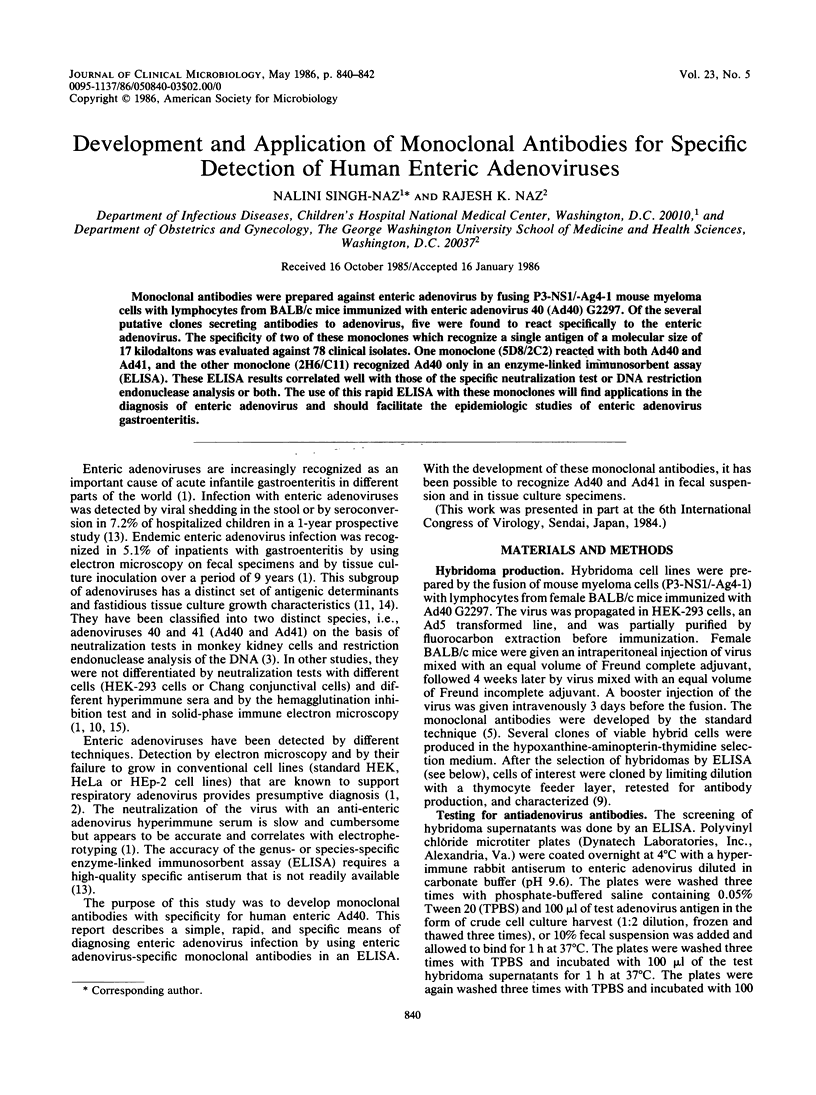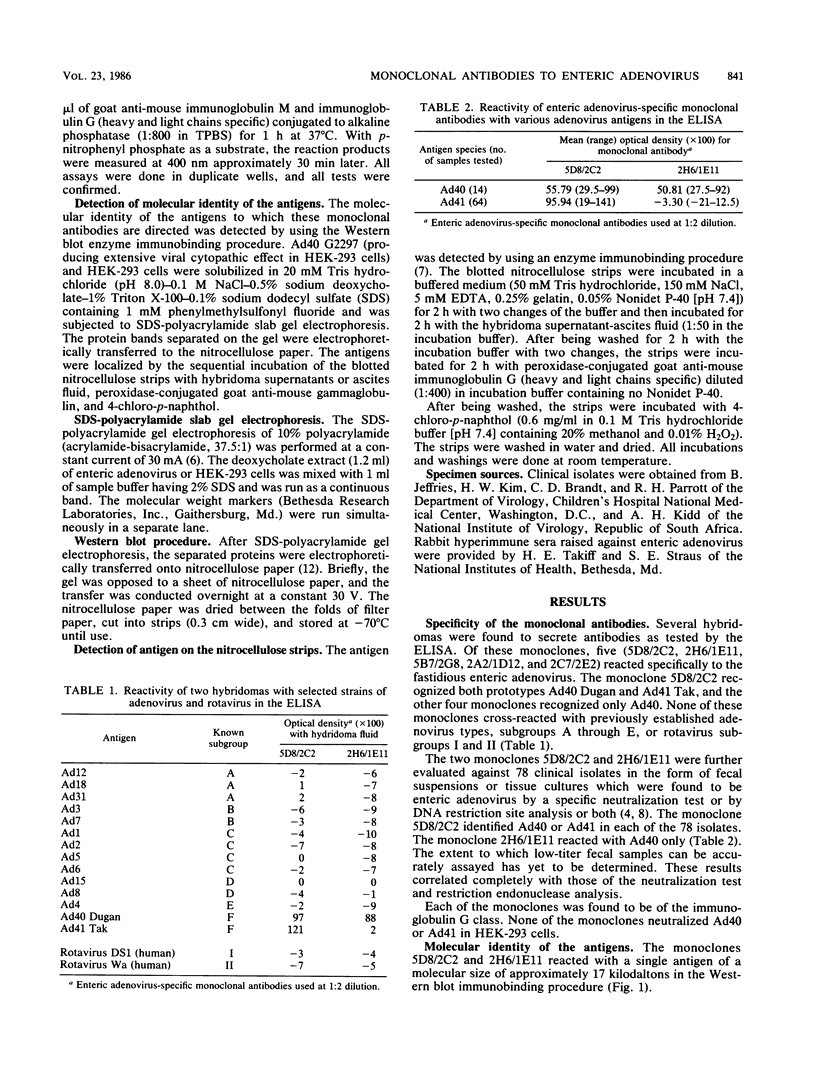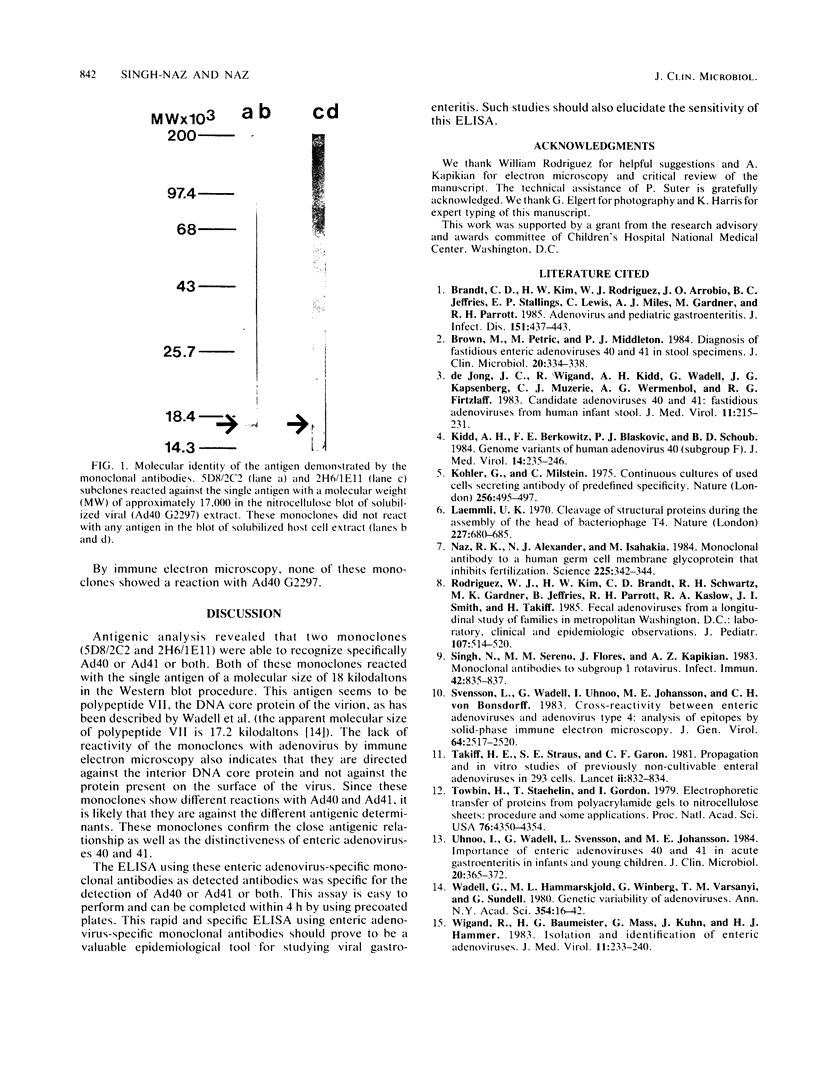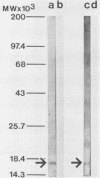Abstract
Monoclonal antibodies were prepared against enteric adenovirus by fusing P3-NS1/-Ag4-1 mouse myeloma cells with lymphocytes from BALB/c mice immunized with enteric adenovirus 40 (Ad40) G2297. Of the several putative clones secreting antibodies to adenovirus, five were found to react specifically to the enteric adenovirus. The specificity of two of these monoclones which recognize a single antigen of a molecular size of 17 kilodaltons was evaluated against 78 clinical isolates. One monoclone (5D8/2C2) reacted with both Ad40 and Ad41, and the other monoclone (2H6/C11) recognized Ad40 only in an enzyme-linked immunosorbent assay (ELISA). These ELISA results correlated well with those of the specific neutralization test or DNA restriction endonuclease analysis or both. The use of this rapid ELISA with these monoclones will find applications in the diagnosis of enteric adenovirus and should facilitate the epidemiologic studies of enteric adenovirus gastroenteritis.
Full text
PDF


Images in this article
Selected References
These references are in PubMed. This may not be the complete list of references from this article.
- Brandt C. D., Kim H. W., Rodriguez W. J., Arrobio J. O., Jeffries B. C., Stallings E. P., Lewis C., Miles A. J., Gardner M. K., Parrott R. H. Adenoviruses and pediatric gastroenteritis. J Infect Dis. 1985 Mar;151(3):437–443. doi: 10.1093/infdis/151.3.437. [DOI] [PubMed] [Google Scholar]
- Brown M., Petric M., Middleton P. J. Diagnosis of fastidious enteric adenoviruses 40 and 41 in stool specimens. J Clin Microbiol. 1984 Sep;20(3):334–338. doi: 10.1128/jcm.20.3.334-338.1984. [DOI] [PMC free article] [PubMed] [Google Scholar]
- Kidd A. H., Berkowitz F. E., Blaskovic P. J., Schoub B. D. Genome variants of human adenovirus 40 (subgroup F). J Med Virol. 1984;14(3):235–246. doi: 10.1002/jmv.1890140307. [DOI] [PubMed] [Google Scholar]
- Köhler G., Milstein C. Continuous cultures of fused cells secreting antibody of predefined specificity. Nature. 1975 Aug 7;256(5517):495–497. doi: 10.1038/256495a0. [DOI] [PubMed] [Google Scholar]
- Laemmli U. K. Cleavage of structural proteins during the assembly of the head of bacteriophage T4. Nature. 1970 Aug 15;227(5259):680–685. doi: 10.1038/227680a0. [DOI] [PubMed] [Google Scholar]
- Naz R. K., Alexander N. J., Isahakia M., Hamilton M. S. Monoclonal antibody to a human germ cell membrane glycoprotein that inhibits fertilization. Science. 1984 Jul 20;225(4659):342–344. doi: 10.1126/science.6539947. [DOI] [PubMed] [Google Scholar]
- Rodriguez W. J., Kim H. W., Brandt C. D., Schwartz R. H., Gardner M. K., Jeffries B., Parrott R. H., Kaslow R. A., Smith J. I., Takiff H. Fecal adenoviruses from a longitudinal study of families in metropolitan Washington, D.C.: laboratory, clinical, and epidemiologic observations. J Pediatr. 1985 Oct;107(4):514–520. doi: 10.1016/s0022-3476(85)80007-x. [DOI] [PubMed] [Google Scholar]
- Singh N., Sereno M. M., Flores J., Kapikian A. Z. Monoclonal antibodies to subgroup 1 rotavirus. Infect Immun. 1983 Nov;42(2):835–837. doi: 10.1128/iai.42.2.835-837.1983. [DOI] [PMC free article] [PubMed] [Google Scholar]
- Svensson L., Wadell G., Uhnoo I., Johansson M., Von Bonsdorff C. H. Cross-reactivity between enteric adenoviruses and adenovirus type 4: analysis of epitopes by solid-phase immune electron microscopy. J Gen Virol. 1983 Nov;64(Pt 11):2517–2520. doi: 10.1099/0022-1317-64-11-2517. [DOI] [PubMed] [Google Scholar]
- Takiff H. E., Straus S. E., Garon C. F. Propagation and in vitro studies of previously non-cultivable enteral adenoviruses in 293 cells. Lancet. 1981 Oct 17;2(8251):832–834. doi: 10.1016/s0140-6736(81)91104-1. [DOI] [PubMed] [Google Scholar]
- Towbin H., Staehelin T., Gordon J. Electrophoretic transfer of proteins from polyacrylamide gels to nitrocellulose sheets: procedure and some applications. Proc Natl Acad Sci U S A. 1979 Sep;76(9):4350–4354. doi: 10.1073/pnas.76.9.4350. [DOI] [PMC free article] [PubMed] [Google Scholar]
- Uhnoo I., Wadell G., Svensson L., Johansson M. E. Importance of enteric adenoviruses 40 and 41 in acute gastroenteritis in infants and young children. J Clin Microbiol. 1984 Sep;20(3):365–372. doi: 10.1128/jcm.20.3.365-372.1984. [DOI] [PMC free article] [PubMed] [Google Scholar]
- Wigand R., Baumeister H. G., Maass G., Kühn J., Hammer H. J. Isolation and identification of enteric adenoviruses. J Med Virol. 1983;11(3):233–240. doi: 10.1002/jmv.1890110306. [DOI] [PMC free article] [PubMed] [Google Scholar]
- de Jong J. C., Wigand R., Kidd A. H., Wadell G., Kapsenberg J. G., Muzerie C. J., Wermenbol A. G., Firtzlaff R. G. Candidate adenoviruses 40 and 41: fastidious adenoviruses from human infant stool. J Med Virol. 1983;11(3):215–231. doi: 10.1002/jmv.1890110305. [DOI] [PubMed] [Google Scholar]



